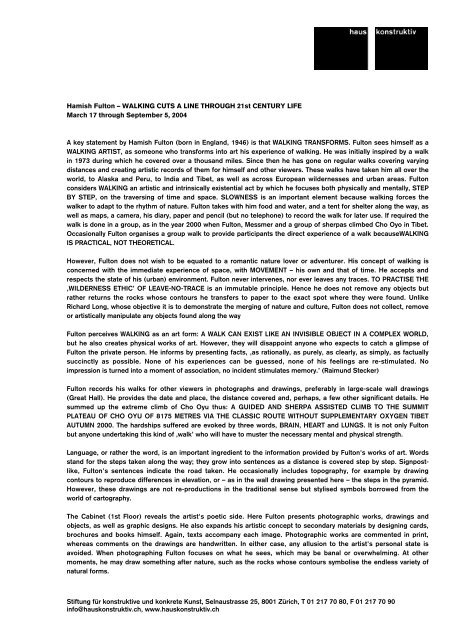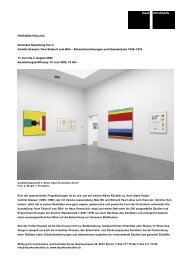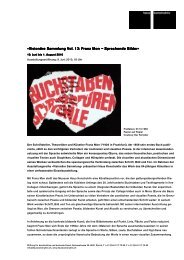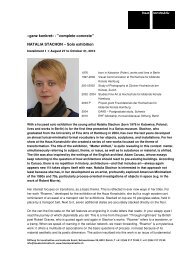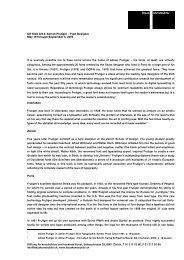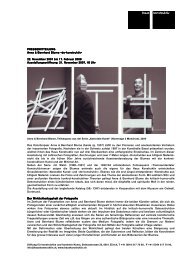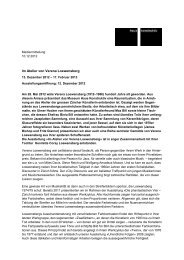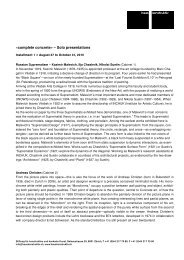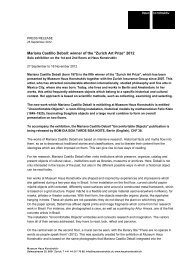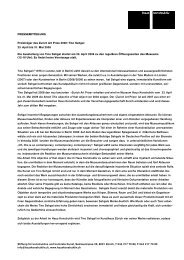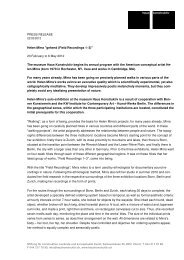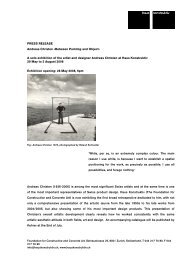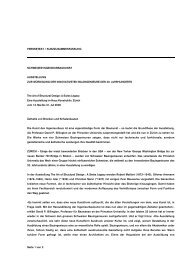Hamish Fulton - Museum Haus Konstruktiv
Hamish Fulton - Museum Haus Konstruktiv
Hamish Fulton - Museum Haus Konstruktiv
Create successful ePaper yourself
Turn your PDF publications into a flip-book with our unique Google optimized e-Paper software.
<strong>Hamish</strong> <strong>Fulton</strong> – WALKING CUTS A LINE THROUGH 21st CENTURY LIFE<br />
March 17 through September 5, 2004<br />
A key statement by <strong>Hamish</strong> <strong>Fulton</strong> (born in England, 1946) is that WALKING TRANSFORMS. <strong>Fulton</strong> sees himself as a<br />
WALKING ARTIST, as someone who transforms into art his experience of walking. He was initially inspired by a walk<br />
in 1973 during which he covered over a thousand miles. Since then he has gone on regular walks covering varying<br />
distances and creating artistic records of them for himself and other viewers. These walks have taken him all over the<br />
world, to Alaska and Peru, to India and Tibet, as well as across European wildernesses and urban areas. <strong>Fulton</strong><br />
considers WALKING an artistic and intrinsically existential act by which he focuses both physically and mentally, STEP<br />
BY STEP, on the traversing of time and space. SLOWNESS is an important element because walking forces the<br />
walker to adapt to the rhythm of nature. <strong>Fulton</strong> takes with him food and water, and a tent for shelter along the way, as<br />
well as maps, a camera, his diary, paper and pencil (but no telephone) to record the walk for later use. If required the<br />
walk is done in a group, as in the year 2000 when <strong>Fulton</strong>, Messmer and a group of sherpas climbed Cho Oyo in Tibet.<br />
Occasionally <strong>Fulton</strong> organises a group walk to provide participants the direct experience of a walk becauseWALKING<br />
IS PRACTICAL, NOT THEORETICAL.<br />
However, <strong>Fulton</strong> does not wish to be equated to a romantic nature lover or adventurer. His concept of walking is<br />
concerned with the immediate experience of space, with MOVEMENT – his own and that of time. He accepts and<br />
respects the state of his (urban) environment. <strong>Fulton</strong> never intervenes, nor ever leaves any traces. TO PRACTISE THE<br />
‚WILDERNESS ETHIC’ OF LEAVE-NO-TRACE is an immutable principle. Hence he does not remove any objects but<br />
rather returns the rocks whose contours he transfers to paper to the exact spot where they were found. Unlike<br />
Richard Long, whose objective it is to demonstrate the merging of nature and culture, <strong>Fulton</strong> does not collect, remove<br />
or artistically manipulate any objects found along the way<br />
<strong>Fulton</strong> perceives WALKING as an art form: A WALK CAN EXIST LIKE AN INVISIBLE OBJECT IN A COMPLEX WORLD,<br />
but he also creates physical works of art. However, they will disappoint anyone who expects to catch a glimpse of<br />
<strong>Fulton</strong> the private person. He informs by presenting facts, ‚as rationally, as purely, as clearly, as simply, as factually<br />
succinctly as possible. None of his experiences can be guessed, none of his feelings are re-stimulated. No<br />
impression is turned into a moment of association, no incident stimulates memory.’ (Raimund Stecker)<br />
<strong>Fulton</strong> records his walks for other viewers in photographs and drawings, preferably in large-scale wall drawings<br />
(Great Hall). He provides the date and place, the distance covered and, perhaps, a few other significant details. He<br />
summed up the extreme climb of Cho Oyu thus: A GUIDED AND SHERPA ASSISTED CLIMB TO THE SUMMIT<br />
PLATEAU OF CHO OYU OF 8175 METRES VIA THE CLASSIC ROUTE WITHOUT SUPPLEMENTARY OXYGEN TIBET<br />
AUTUMN 2000. The hardships suffered are evoked by three words, BRAIN, HEART and LUNGS. It is not only <strong>Fulton</strong><br />
but anyone undertaking this kind of ‚walk’ who will have to muster the necessary mental and physical strength.<br />
Language, or rather the word, is an important ingredient to the information provided by <strong>Fulton</strong>'s works of art. Words<br />
stand for the steps taken along the way; they grow into sentences as a distance is covered step by step. Signpostlike,<br />
<strong>Fulton</strong>'s sentences indicate the road taken. He occasionally includes topography, for example by drawing<br />
contours to reproduce differences in elevation, or – as in the wall drawing presented here – the steps in the pyramid.<br />
However, these drawings are not re-productions in the traditional sense but stylised symbols borrowed from the<br />
world of cartography.<br />
The Cabinet (1st Floor) reveals the artist's poetic side. Here <strong>Fulton</strong> presents photographic works, drawings and<br />
objects, as well as graphic designs. He also expands his artistic concept to secondary materials by designing cards,<br />
brochures and books himself. Again, texts accompany each image. Photographic works are commented in print,<br />
whereas comments on the drawings are handwritten. In either case, any allusion to the artist's personal state is<br />
avoided. When photographing <strong>Fulton</strong> focuses on what he sees, which may be banal or overwhelming. At other<br />
moments, he may draw something after nature, such as the rocks whose contours symbolise the endless variety of<br />
natural forms.<br />
Stiftung für konstruktive und konkrete Kunst, Selnaustrasse 25, 8001 Zürich, T 01 217 70 80, F 01 217 70 90<br />
info@hauskonstruktiv.ch, www.hauskonstruktiv.ch
In <strong>Fulton</strong>'s opinion art is not about stroking the artistic ego. Basically, MAKING ART SHOULD BE AS SIMPLE AS<br />
SWEEPING THE FLOOR. <strong>Fulton</strong> chose walking as an art form: „<strong>Hamish</strong> <strong>Fulton</strong> walks the way a painter paints.“<br />
(Raimund Stecker) His works are about walking and refer to the characteristics of this activity. The actual experience,<br />
however, is absent and may at best be intuited: AN ARTWORK CANNOT RE-PRESENT THE EXPERIENCE OF A WALK.<br />
<strong>Fulton</strong> emphasises that it remains elusive, immaterial, unique, impossible to apprehend through mere description,<br />
and gives us an idea of what EXPERIENCE may mean. WALKING not only has a basis in reality, but claims a<br />
philosophical position of cultural criticism. One might want to accept the invitation extended by <strong>Fulton</strong>'s art to make<br />
one's own experience, reach one's own insights.<br />
Elisabeth Grossmann, Curator<br />
We greatly appreciate the financial support by Allreal AG, the British Council, the Stanley Thomas Johnson Foundation<br />
and Ringier AG. This exhibition was created in cooperation with Häusler Contemporary, München, Germany. The wall<br />
drawings in the great hall were executed by Cordula Huber and Marlyse Meyerhofer.<br />
Opening hours:<br />
Public guided tours:<br />
April 29, 2004, 6pm<br />
June 22, 2004, 6pm<br />
Wed/Fri 12-6pm, Thur 12-8pm, Sat/Sun 11am-6pm<br />
Thursdays 12:15pm; Sundays 11:15am; every first Thursday of the month, 6:30 pm. Guided<br />
tours for groups upon request.<br />
<strong>Hamish</strong> <strong>Fulton</strong> – Guided tour in English by Felicity Lunn followed by an apéro (sponsored by<br />
the British Council). Free admission.<br />
<strong>Hamish</strong> <strong>Fulton</strong> – Public talk by <strong>Hamish</strong> <strong>Fulton</strong>, „Between Image and Reality.“<br />
ETH Hönggerberg, Auditorium HIL E4. Free admission.<br />
(Please note that this event has been postponed from June 15 to 22.)<br />
© Translation from German:<br />
Margret Powell-Joss<br />
mpowelljoss@swissonline.ch<br />
Stiftung für konstruktive und konkrete Kunst, Selnaustrasse 25, 8001 Zürich, T 01 217 70 80, F 01 217 70 90<br />
info@hauskonstruktiv.ch, www.hauskonstruktiv.ch


